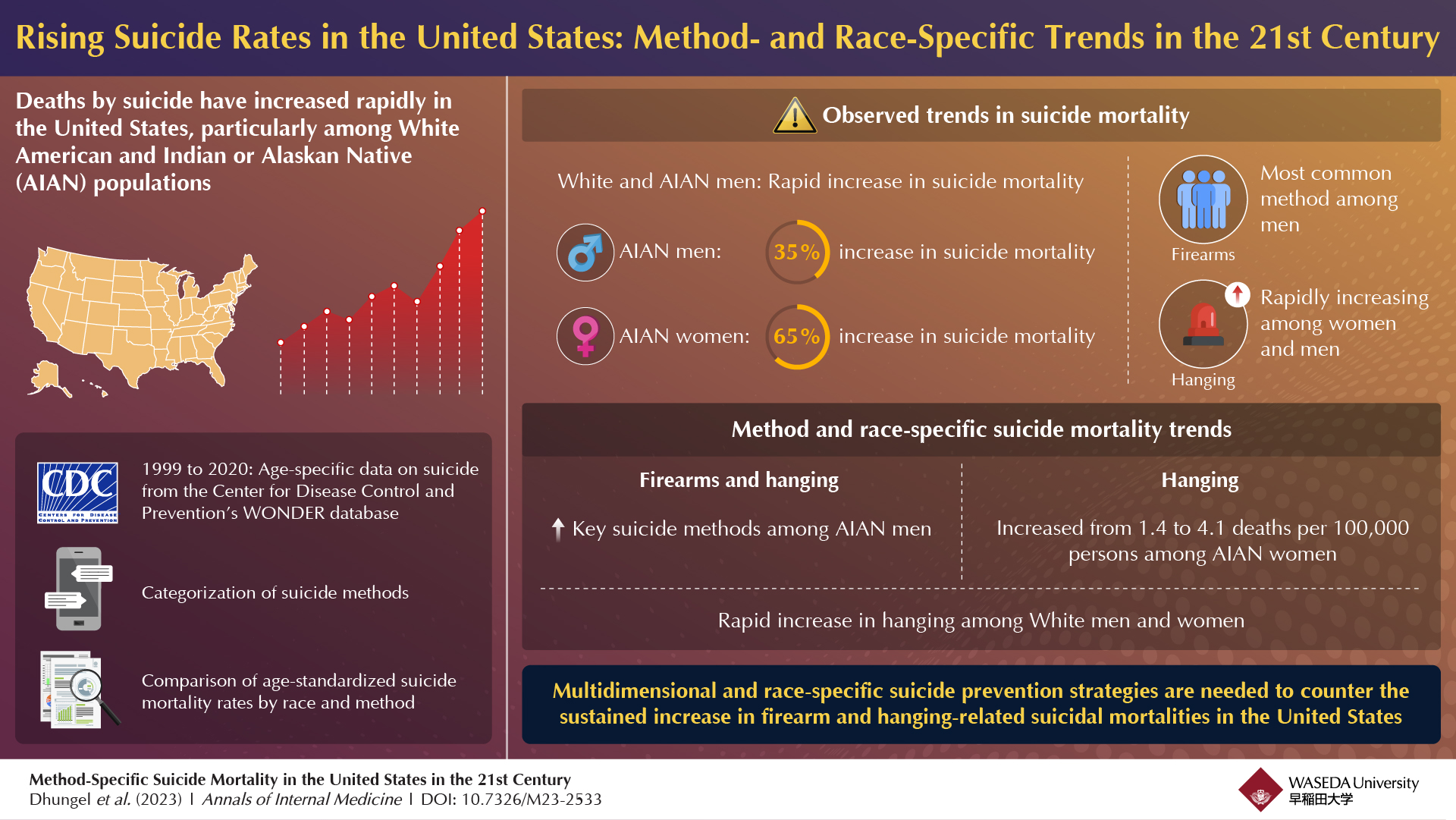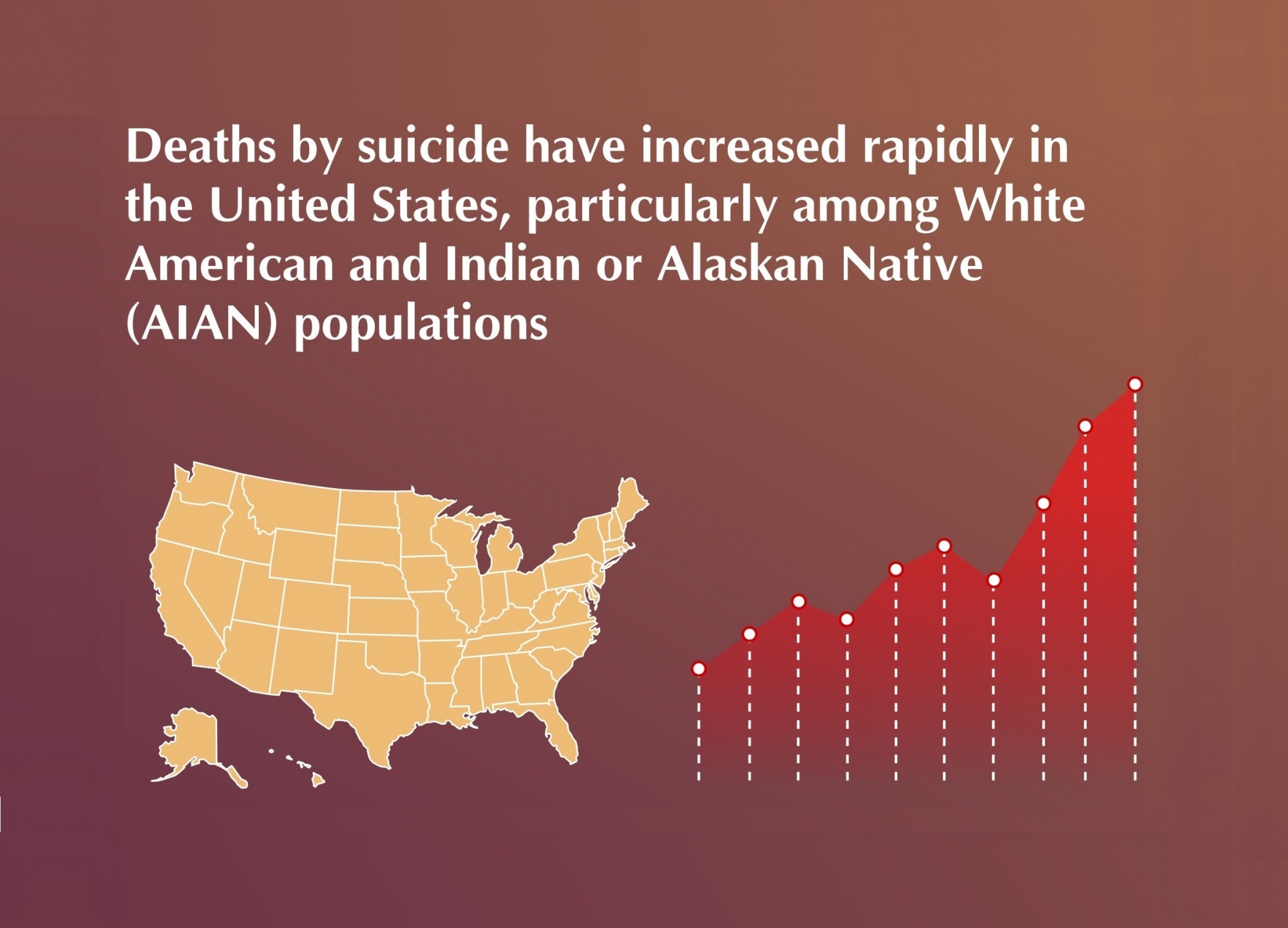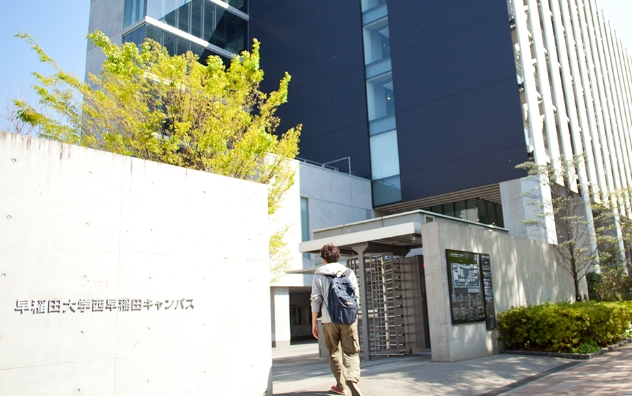Suicide and Race: Uncovering Patterns Underlying Increasing Suicide Rates in the USA
Thu, Jan 25, 2024-
Tags
Suicide and Race: Uncovering Patterns Underlying Increasing Suicide Rates in the USA
Researchers have identified specific communities in the United States where the majority of suicides occur by firearm and hanging
Suicide rates in the United States have surged in the 21st century. Now, a team of researchers from Japan, China, and Australia have analyzed data on method-specific suicide mortality in the United States spanning the last two decades. Their study aims to assess temporal trends and patterns in method-specific suicide for both sex and race. Moreover, they discuss how economic and cultural factors within communities influence the method of suicide. These findings hold promise for improving mental health interventions targeting vulnerable populations.

Suicide mortality rates have increased rapidly in the United States compared to those globally. In this study, researchers show that AIAN and White people have the highest risk of suicide by firearm or hanging.
Are there specific communities that bear the brunt of suicide mortality? Certain studies have revealed that historically marginalized and economically deprived indigenous populations are linked with higher rates of cluster suicides—especially in Canada, the United States, and Australia. Public health officials need to consider that the risk of suicide contagion—social transmission due to insufficient interventions and resources—is real and must be countered. Now, a consortium of public health experts from Japan, Australia, and China have analyzed trends in suicide mortality in American Indian or Alaskan Native (AIAN) populations, while exploring health inequality among vulnerable populations. The team, led by Assistant Professor Bibha Dhungel from the School of International Liberal Studies, Waseda University, including co-authors Dr. Fiona Shand, Associate Professor, University of New South Wales, Australia, Dr. Jinghua Li, Associate Professor, Sun Yat-sen University, China, and Dr. Stuart Gilmour, Professor, St. Luke’s International University, Japan, published their findings in the Annals of Internal Medicine on December 19, 2023.“In contrast to global suicide rates which decreased by nearly a third between 1990 and 2016, those in the United States saw a rapid increase. ” explains Dr. Dhungel. She further added, “We wanted to study these trends over time in the hopes of distilling underlying patterns specific to sex and the method of suicide.” Studies have reported that the life expectancy of AIAN individuals is seven years less than that of the White population.
The team examined age-specific data on self-harm from the Centers for Disease Control and Prevention’s WONDER database over the study period. They profiled suicides by poisoning, hanging, firearms, jumping from high places, and other methods and compared mortality rates per 100,000 persons by method and race for both sexes. Suicide methods were classified using the 10th Edition of the International Classification of Diseases. Dr. Dhungel notes, “Suicide mortality rates among White and AIAN men increased rapidly between 1999 and 2020. The highest rates were observed among White individuals, followed by AIAN populations. Furthermore, the relative increase in rates since 2000 among AIAN men and women was 35% and 65%, respectively. In fact, suicide by firearm and hanging was prevalent among AIAN men, and suicide by hanging increased by nearly 200% among AIAN women.”
Furthermore, the team believes that these trends reflect the historical trauma and that ongoing inequality and discrimination contribute to the high suicide rates in AIAN people, potentially rendering AIAN communities more vulnerable to mental health issues. The study underscores the imperative to address mental health in vulnerable populations and equip clinicians to identify high-risk groups associated with various suicide methods.
Dr. Dhungel concludes, “By implementing comprehensive and focused community-based suicide prevention strategies that are racially relevant, communities can work towards a more inclusive approach to suicide prevention. The goal is to reduce suicide rates by addressing the specific needs and challenges faced by different racial groups, ultimately fostering mental well-being and resilience across diverse populations.”
Reference
Title of original paper: Method-Specific Suicide Mortality in the United States in the 21st Century
DOI: 10.7326/M23-2533
Journal: Annals of Internal Medicine
Article Publication Date: 19 December 2023
Authors: Bibha Dhungel1, Fiona Shand2, Phuong Nguyen3, Yijing Wang4, Sayuri Fujita-Imazu5, July Khin Maung Soe5, Jinzhao Xie6, Xinran Wang6, Jinghua Li7, Stuart Gilmour8
Affiliations:
1. School of International Liberal Studies, Waseda University, and Department of Health Policy, National Center for Child Health and Development, Tokyo, Japan
2. The Black Dog Institute, University of New South Wales, Randwick, New South Wales, Australia
3. Graduate School of Public Health, St. Luke’s International University, and Division of Surveillance and Policy Evaluation, National Cancer Ce
nter Institute for Cancer Control, Tokyo, Japan
4. Shenzhen Center for Disease Control and Prevention, Shenzhen, China
5. Graduate School of Public Health, St. Luke’s International University, Tokyo, Japan
6. School of Public Health, Sun Yat-sen University, Guangzhou, China
7. School of Public Health and Sun Yat-sen Global Health Institute, Institute of State Governance, Sun Yat-sen University, Guangzhou, China
8. Graduate School of Public Health, St. Luke’s International University, Tokyo, Japan














